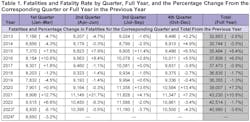The National Highway Traffic Safety Administration released its first projections for traffic fatalities in 2024.
The administration estimates that 8,650 people died in traffic crashes in the first three months of the year. This represents a decrease of about 3.2% as compared to 8,935 estimated fatalities during the same period in 2023.
Preliminary data for the first quarter marks the eighth consecutive quarterly decline in traffic fatalities, a trend that began in the second quarter of 2022.
The projected decrease comes as vehicle miles traveled increased 0.6% from January through March. The estimated fatality rate for the first three months of 2024 decreased to 1.13 fatalities per 100 million vehicle miles traveled, down from the projected rate of 1.18 fatalities during the same period in 2023.
“We’re encouraged to see traffic fatalities continue to decline, but more work must be done to reduce these preventable tragedies on our roads,” said NHTSA Deputy Administrator Sophie Shulman. “NHTSA is working diligently to save lives and ensure our roads are safe for everyone inside and outside of vehicles.”
NHTSA estimates that fatalities decreased in 30 states and Puerto Rico in the first quarter of 2024, while increases are projected in 19 states and the District of Columbia, compared to the same period in 2023. One state remained unchanged.
See also: FMCSA launches annual Our Roads, Our Safety Week
National roadway safety progress
Earlier this year, the U.S. Department of Transportation published its 2024 Progress Report, marking two years since the release of the original National Roadway Safety Strategy on Jan. 27, 2022. The progress report provides an update on the department’s efforts to address serious and fatal injuries on roadways and details the department’s accomplishments related to addressing the NRSS actions in 2023. According to NHTSA, the most significant actions in 2023 include:
- Awarded $1.7 billion in funding to improve roadway safety at the local, regional, and tribal levels through the Safe Streets and Roads for All discretionary grant program. More than 1,000 communities received funding, representing close to 70% of all Americans.
- Accelerated the deployment of new vehicle safety technologies through rulemakings for automatic emergency braking, including for pedestrians, on all new passenger vehicles as well as heavy vehicles such as commercial trucks.
- Initiated an advance notice of proposed rulemaking for impaired-driving prevention technology standards to inform requirements that will deter behaviors such as alcohol-impaired driving.
- Updated key road safety regulations such as the new edition of the Manual on Uniform Traffic Control Devices, and revised guidance to encourage states using federal aid funds to use repaving and rehabilitation projects to improve safety for all road users.
- Expanded the use and support of the National Emergency Medical Services Information System by accepting data from all 50 states, two territories, and the District of Columbia.
- Welcomed more than 123 organizations that have joined as Allies in Action of the NRSS, including 36 state transportation agencies and safety offices.
About the Author
FleetOwner Staff
Our Editorial Team
Kevin Jones, Editorial Director, Commercial Vehicle Group
Josh Fisher, Editor-in-Chief
Jade Brasher, Senior Editor
Jeremy Wolfe, Editor
Jenna Hume, Digital Editor
Eric Van Egeren, Art Director

